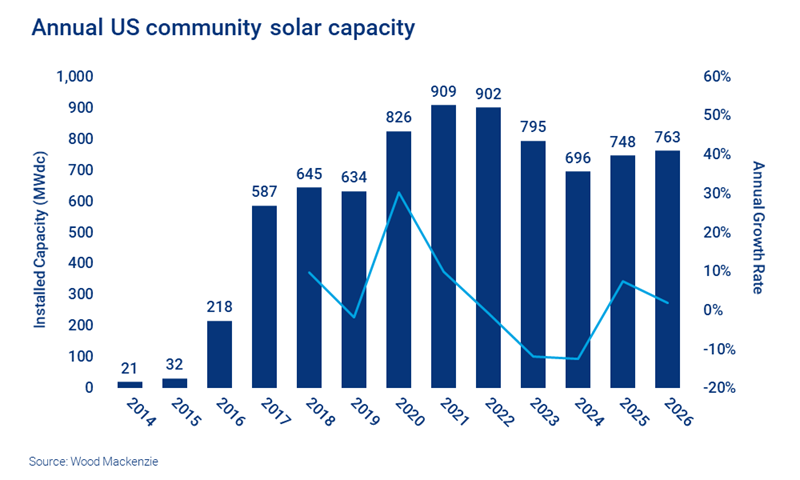US community solar market faces a near-term peak
Current incentives drive growth for the next two years – but a decline will follow if programs and incentives are not expanded
1 minute read
Community solar is currently winning an increasing market share in the US. State-level programs and incentives fueled a record-breaking year of growth in 2020, accounting for 37% of annual non-residential solar capacity – up from just 13% in 2016. Now, with new programs emerging and mature markets facing challenges, can the sector maintain its growth?
A full analysis of the market, including five-year forecasts for the largest state programs, can be found in our US community solar market outlook 2021, created in collaboration with the Coalition for Community Solar Access (CCSA). Fill in the form for a complimentary extract. Or read on for some key highlights.
US community solar: current state of play
Community solar refers to local solar facilities shared by multiple community subscribers, such as residential homeowners and renters and commercial businesses that receive credits on their electricity bills for their share of the power produced.
As it sits now, the community solar market will experience a peak in installations over the next few years. As current incentives become fully allocated and those projects come online over the next two years, the market will see a decline starting in 2023 without an expansion of programs and incentives.
As some mature markets stabilize, emerging state programs promise rapid growth
Much of the growth over the next five years will come from burgeoning new markets like New Jersey, Illinois, and Maine. These state markets will account for 1,500 MW of direct current (MWdc) in that timeframe. In addition, market leaders New York and Massachusetts are projected to bring over 2,000 MWdc online during the same time span.
Meanwhile, without policy reforms that remove constraints on the market, longstanding markets like Colorado and Minnesota will shrink. Siting restrictions, interconnection challenges, and grid upgrade costs all continue to suppress some state markets.
Lessons learned from existing programs can build successful new markets
Community solar programs are unique to each state and can be more complex than other solar market segments. Historically, programs with less restrictive caps, simple siting allocation rules, and favorable compensation for the subscriber have been more successful. New state programs and expansions to existing programs can reflect on past successes and failures to build more effective programs and incentive structures.
Ensuring that the customer will see a financial benefit to obtaining a subscription is key to a program’s success. Fair, stable rates that are easily communicable tend to result in more successful customer engagement, and clear compensation structures help to establish trust. Programs like that in Minnesota provide long-term certainty for customers due to a permanent value of solar tariff (VOST) that isn’t capped and experiences a slight average annual decline of 3%. On the other hand, states with temporary incentive programs typically see a surge of capacity additions that eventually drop off. Even when states with temporary programs establish successor programs, developers and advocates find that changes can lead to rate structure uncertainty, confusion for customers, and massive investments in time and resources to create favorable new programs.
Reasonable siting and zoning rules, along with clear processes for grid upgrades to enable interconnection, are also crucial for a successful market. Both mature and emerging markets are facing issues related to siting restrictions. Restrictive county-level zoning rules in Maryland have hindered growth for the small market. Additionally, contiguous county rules in Minnesota, which many advocates and developers perceive as arbitrary, have stifled the nation’s leading community solar market.
Interconnection of community solar projects is often dependent on grid upgrades. For developers to bring projects to fruition, they need clarity on interconnection and upgrade requirements and costs. Challenges or uncertainty around costs and how they will be paid for can lead to delays and hinder customer acquisition.
Community solar carveouts for low- and moderate-income customers are increasingly prevalent
Community solar can help low- and moderate-income (LMI) customers reduce their electricity bills, and LMI carveouts have become common within state-level community solar programs.
Advocates and developers say that arduous income verification requirements are a major pitfall of acquiring LMI customers. Each state program has its own rules and requirements, and both customers and developers struggle under programs that require multi-year customer-supplied income verification, such as tax returns or salary statements. These time-consuming processes can also be uncomfortable for potential customers – many would rather not share sensitive personal information.
Preferable program requirements involve automatic qualification via census tract regions or enrollment in other state or federal programs such as the Low Income Home Energy Assistance Program (LIHEAP). Additionally, some advocates say that simple self-attestation of income for qualification would be the most efficient and fair process that would both speed up the verification process and inspire trust with the customer.
Community solar is growing, and learning from successful programs can help new programs thrive
Community solar is shaping up to become a more significant part of non-residential solar capacity over the next five years. As a unique market segment with a diverse customer base and varying state programs, recognizing best practices will be key to replicating successful models. This outlook reflects policy and market conditions as they exist today. There is considerable upside if programs and incentives are expanded.






